|
|
Zeiss Ikon – Model Kinox – S 16 mm silent film projector 16 mm - 1939 (Fl.)
This model - Kinox S silent projector appeared on the English market in 1939. The projector was described in the 1939, Zeiss Ikon catalog, issued in the UK.
As it was produced for the English market, all description on the projector is in English language.
The projector is built and designed in a very futuristic style, at the time of the production.
It is easy to attend to any compartments of the projector.
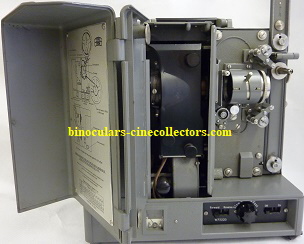 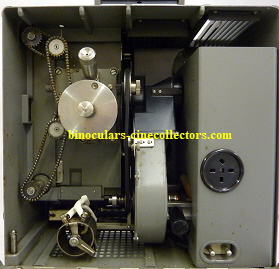
Pict 2; Zeiss Ikon 16 mm Model Kinox-S; the front compartment & back; ©Anna Vacani
In the late 30-es in similar way was designed the body of Agfa projector – Agfa Movector Jso 1938
16 MM projector.
The instruction book to our projector is in German language, and it was printed in December 1938. However, the projector left the factory in November 1939, as indicates the correction leaflet inserted into the instruction book.
The instruction book is in German language, and has a separate leaflet “Illustrations for the instruction booklet of the Zeiss Ikon 16 mm projector KINOX –S” in 4 languages – German; English, French and Spanish.
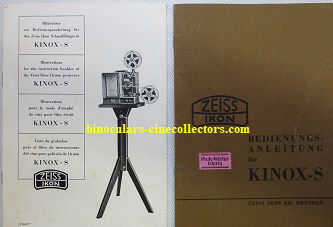
Pict 3; Zeiss Ikon 16 mm Model Kinox-S; instruction& leaflet; ©Anna Vacani
The projector was priced, on the English market as – £ 68, s 10, d 0 (pounds, s=shillings, d=pence). It was a very expensive projector in that time.
The projector takes film spools for 400 or 800 ft; on the projector door is specified in meters, as “Spool arm catch for 120 m or 250 spools”
The projector is in the case - Pict 1
In the case are: - the projector; the resistance; and many spare parts and tools.
The projector has some special cables with different types of plugs than normally used in England:
- Two pin plugs to fit projector – sometimes named “heat plug”. It was fitted into electric irons and vacuum cleaners before the war.
- Another end of the cable has a two pin plug.
- The plug on the resistance box is four pins three-phase plug – 380V type German manufactured produced.
Our two other Kinox-S projectors (described above) do not have the resistances.
Features of the projector
- The body
The body is die casting, which takes the form, when closed of a small metal carrying case. The case is with exterior integral texture finished in gray enamel with polished parts.
The side with running controls has two doors; one is for access to running films mechanism and other one is for adjusting and replace lamp. The back side has one door along the body. Opening this door it is access to main mechanism, drive belt, lubrication point, and access to changed shutter.
In the first front side inner door is an instruction in English language - how to operate all mechanism fitted into the projector (Pict.4).
The projector can be fitted with two blades shutter for maximum light output. It can also use three blades shutter when showing silent speed film for less flicker.
- Lubrication
The projector has to be often oiled and lubricated. In many places are some tiny holes, marked in red, and indicated where oil should be inserted. The lubrication should be applied into gear wheel. Over the gear wheel is a tube with a tiny hole. The top screw must be loosened from time to time and checked, whether the pinion (gear wheel) visible in the opening is still sufficiently lubricated.
As the instruction book indicates “If necessary, add some grease from the supplied syringe. A few cubic centimeters will suffice; too much is of evil, since the excess fat is then squeezed out of the bearings. After filling, the screw has to be closed again.”
Later on, the oil container was redesigned. In our projector, produced in 1943 -Production No: W. 29205 - described above , it looks deferent, comparing to the projector from 1939.
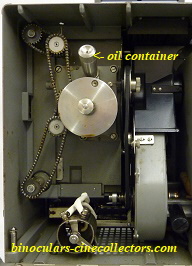 
Pict 5, 6; Zeiss Ikon 16 mm Model Kinox-S – 1939 &1943; Pict 5 oil tube in 1939; Pict 6 in 1943 ©Anna Vacani
- Lens and optical system
The optical system of the projector consists of the Kinostar = S lens; 1:1, 8 F=5 cm focal length production No. 1350970, in conjunction with an optically worked concave mirror and special condenser (Pict 2) . The lens is a sleeve fit into the focusing mount.
- Lamp
The lamp is kept cool by means of a powerful fan. Inside of the projector, next to the lamp is a plate which informs what a lamp should be fitted into the projector. Our projector takes lamp – A1/7prefocuse cap 100v 500W 5 amp; model that was sold in the UK had the lamp A1/7, 110V, 500W, 4,5amp, according to 1939 catalogue Zeiss.
The projector has a built-in the amperage control for the lamp (Pict 13).
It is very easy to attend to the lamp compartment and exchange the lamp if necessary.
When using with a 100 V 500W lamp set 5 amp or using 110V 500W lamp set 4,5amp, adjust it correctly – in clockwise on the meter, using control (point Nr 13) on rear of the projector. It is possible to adjust only when the projector has been started.
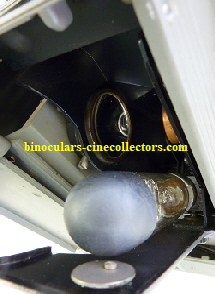 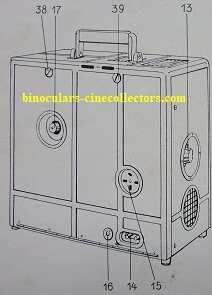
Pict 7; Zeiss Ikon 16 mm Model Kinox-S; Lamp and lamp compartment; Lamp control ©Anna Vacani
- Motor
The Zeiss Ikon 16 mm Kinox-S model projector is running on a resistance with 4 pins plug. It drives on V belt and 4 chains and it has three blades shutter (Pict 2).
The power of the resistance is described on both sides. The symbols applied to the resistor are: “=” direct current, and symbol ~ as an alternating current.
In order to prevent the changeover of the knob (Pict 8b) to prevent unauthorized persons, the toggle – (on top in the picture) is provided, which releases the path for the changeover of the knob after pulling up.
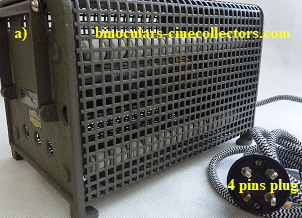 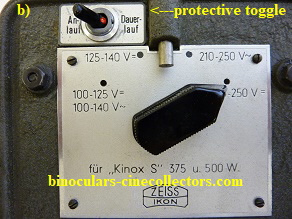

Pict 8a, b, c; Zeiss Ikon 16 mm Model Kinox-S; resistance; ©Anna Vacani
The socket, visible in the picture Pict 7 point Nr 15; is intended for the four-pin plug of the resistor or transformer.
The resistor is designed for both the 375 watt and 500 watt lamps, and can be used with DC and AC power.
The projector has a special feature. It cannot to be switched on until the lamp resistance control, at the back of the projector is turned fully anticlockwise, which unblocks the switch. It is visible in the picture from the instruction – point Nr 8.
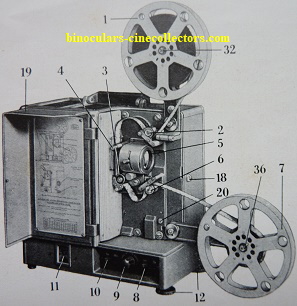
Pict 9; Zeiss Ikon 16 mm Model Kinox-S; instruction book; ©Anna Vacani
- Sprockets
The projector has 2 normal sprockets associated with the film input and output. An additional sprocket, like device is at the bottom and it is used as part of the Maltese Crosse film movement.
- The film loading
The instruction of a film loading is fitted on the projector’s door (Pict 4).
The movement of the film through the gate of the projector is controlled by Maltese cross movement, which not only prevents wear and tear on the film, but in addition the time taken to shift the film for each picture is shorter than with the claws method, assists illumination.
The mechanism and history of the Maltese cross described Gerald McKee in his book – “The Home Cinema, CLASSIC HOME MOVIE PROJECTORS 1922 – 1940”.
“This mechanism consisted of a star shaped wheel with four arms, which when
struck by an eccentrically mounted pin advanced a sprocket (sharing the
same spindle as the star wheel), a frame at a time. The sprocket wheel was in
constant mesh with the film. The whole beauty of the Maltese Cross was that it
was self-locking between its movements: a cam on the striking shaft mating with
the matching curved shape of the star wheel, during the "still" projection
phase. Although it was probably the best of all intermittents, it required high
quality engineering in its manufacture, and preferably its moving parts should
be working in an oil bath to lubricate the striking surfaces. But when well-made
it gave extremely steady projection, and was the standard intermittent in most
of the 35 mm professional, theatre-size motion picture projectors during the
cinemas' heyday. It was pioneered by R.W.Paul on his THEATROGRAPH in 1896,
and Thomas Armat - in the States - on his VITASCOPE in 1896 (the projector to be
promoted by Edison as his PROJECTING KINETOSCOPE). For home projectors, the
Maltese Cross was often used by Butcher and others for their small 35 mm projectors,
following the theatrical pattern, and - curiously - primitive Maltese Cross
movements were to be seen on toy 35 mm machines for children. When it came to
narrow-gauge projectors, the Maltese Cross was not usually used. There were
problems with getting an adequate drive, because the non-flam gauges had only
one sprocket hole per frame, against the four of 35 mm.”
The film guide way has to be clean occasionally. Pull out the gate, holding the knurled end ( Pict 10 & 11).
- Speed
The device has variably speed control; Forward, Reverse, Slow, Fast.

Pict 12; Zeiss Ikon 16 mm Model Kinox-S; speed control & control lamp amperage; ©Anna Vacani
- Accessories and spare parts:
The projector is in the original carrying box well designed. It consists of compartments for:
- the projector; resistance box; cables – power cable and resistance cable with 4 pin plug; screwdriver and spare parts: two bladed shutter; bottle of Zeiss Ikon special oil – bottle was never opened; magnify glass; concave mirror; objective lens F= 6,5 cm superior Kinon Meyer Goerlitz; spring belts; motor brushes; cleaning sticks for film gate.
- Tilt Two tilt adjusters are fitted on the front of the projector.
- Measurement of projector
Dimension - 6” x 12” x 12 ½”; (406 mm x 304,8mm x 304,8mm); Weight 25 lb = 11.3398 kg.
Production No: W.72220
- Summarizing
It is a very well designed device with stream line appearance. We suppose that the projector was based on a similar style of Agfa Movector 16 mm.
The projector has some intelligent features, as - control switch on; adjustment for the lamp. These elements prevents damages to the device.
Bibliography
The description of the projector is based on the owners’ knowledge; instruction book and other cine literature, with special use of Gerald McKee book – “The Home Cinema, CLASSIC HOME MOVIE PROJECTORS 1922 – 1940”- in our library.
|
|

Pict 1; Zeiss Ikon 16 mm Model Kinox-S with the case; ©Anna Vacani
Pict 4; Zeiss Ikon 16 mm Model Kinox-S; instruction on the door; ©Anna Vacani
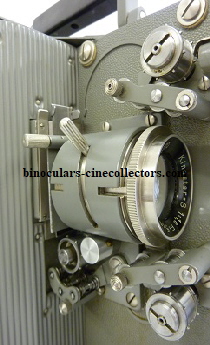
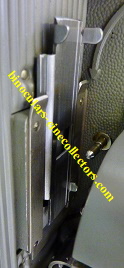
Pict 10 & 11; Zeiss Ikon 16 mm Model Kinox-S; guide way & cleaning gate; ©Anna Vacani
|